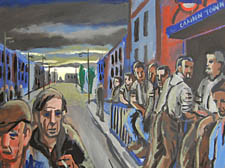|
|
 |
| |
Tribute to the boys who rebuilt London
Bernard Canavan’s new exhibition shows the lives of his fellow Irish émigrés who came to the post-war capital, writes Peter Gruner
IT’s early morning outside Camden Town Tube station in the 1960s and dozens of Irishmen are waiting for work.
Artist Bernard Canavan, who painted the striking scene, remembers that many of the group looked gaunt and tired, possibly hung over from a previous night’s drinking.
Soon a man in a lorry or van will turn up and choose 20 of the ablest looking to work on a building site somewhere in north London.
The painting is part of a new exhibition, The Faithful Departed, at the Hammersmith Irish Cultural Centre, which began this week.
Canavan, originally from Camden, who now lives in neighbouring Willesden, has included a number of local scenes. His painting titled Camden Pub, he said, is a juxtaposition of many similar establishments, showing a group of men drinking in the 1950s. “Irish pubs in those days were very male-oriented,” he said. “Women rarely entered one. There would often be fights and lots of shouting and swearing.”
Murphy’s Men, named after the contractor group, portrays men talking in a pub with a group of beehive-haired women, who are very much outsiders.
Canavan, who was born in Longford, mid-Ireland, lived in Agar Grove close to the Camden Irish Centre and at The Vale of Health in the 1960s. He once ran a folk song and poetry club in the Dublin Castle. He later drew cartoons and sketches for underground papers like Oz and International Times, along with then established titles like New Society (now defunct).
More than 800,000 Irish came over after the war to help re-build Britain. “The women worked in hospitals, hotels or small light factories and the men did the building. Many have died off or returned home,” he said.
“The big Irish communities of Camden and Islington are no longer there.”
|

|
 |
|
 |
|

